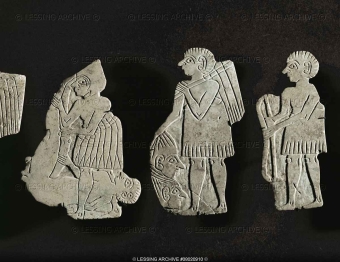You are seeing an unstyled version of this site. If this is because you are using an older web browser, we recommend that you upgrade to a modern, standards-compliant browser such as FireFox [http://www.getfirefox.com/], which is available free of charge for Windows, Mac and Linux.
Digital Corpus of Cuneiform Lexical Texts: Ebla

Marble intarsia from the palace of Ebla. © Lessing Archive
Recommended browser for this site is Chrome; Mozilla should work fine as well. There are known problems with Internet Explorer.
DCCLT/Ebla is a cooperative project by Marco Bonechi (CNR) and Niek Veldhuis (DCCLT/UC Berkeley NES). The site will publish all lexical texts that were found at Ebla, modern day Syria.
The Ebla lexical texts were found in the royal archives that preserve accounts of the last few decades of the history of this powerful kingdom, just before it was destroyed. The Ebla archives contain more than 15,000 texts which primarily document the expenses of the palace, but also include a (comparatively) small number of literary texts, lexical texts and incantations. The language of the administrative texts is an early East Semitic dialect that it shared with Mari, Kiš and Northern regions. The writing system is heavily logographic, using Sumerian signs to write the Eblaite words, but syllable signs for writing names, possesive suffixes, prepositions, etc. The archives deal with the distribution of, for instance, clothing and jewelry, and often mention the occasion for which the expense was made. Thus we learn about messengers coming from various areas, about the marriage of an Ebla princess with the son of the king of Kiš and numerous military events.
The Ebla archives were found in situ, in part still standing on their original shelves, in part dropped to the ground. The thorough destruction of the palace certainly contributed to the fact that the archives have been recovered in a fairly complete fashion.
The scribes of Ebla were scribes in service of a powerful kingdom, with a very broad geographical horizon, extending all the way to Kiš in Babylonia proper. The lexical texts that we find here include exercises, meant to learn the cuneiform tradition. But we also encounter large and beautifully inscribed display copies that betray the hand of an accomplished scribe. The Ebla scribes were not content to simply copy the lexical corpus as it was developed in Babylonia. They found the inspiration to create their own texts, including the very first bilinguals in history.
The about 150 lexical tablets from Ebla that will be presented here may be divided into three groups. The first group consists of very traditional lists that were known everywhere where cuneiform was used (the all-Babylonian tradition). These lists go back to the late fourth millennium and were faithfully copied from one generation to the next. A second group was known primarily in Northern Babylonia. The Ebla scribes had learned their trade from colleagues at Mari and (perhaps) Kiš, where this same Northern tradition was used. Finally, Ebla scribes introduced their own set of lexical texts, including bilingual (Sumerian - Akkadian) lists and thematic lists of words in (the Ebla dialect of) Akkadian
The lexical texts presented here have been edited and translated by Marco Bonechi. Niek Veldhuis is responsible for the transformation of the files to ORACC/DCCLT standards, with the assistance of Lidewij Arthers.